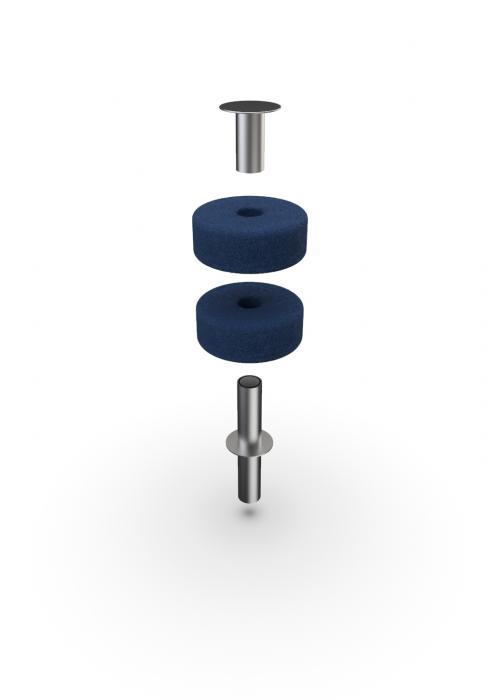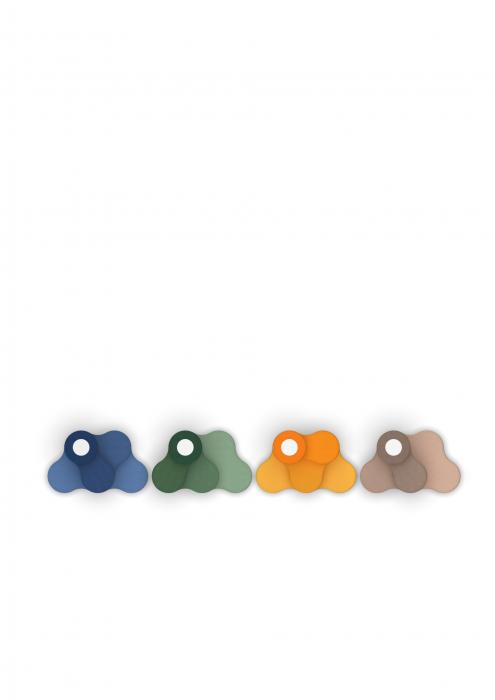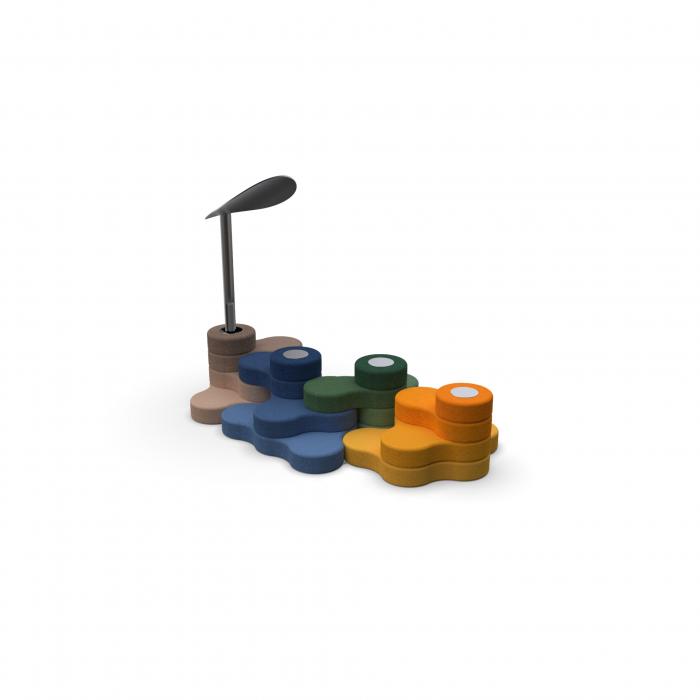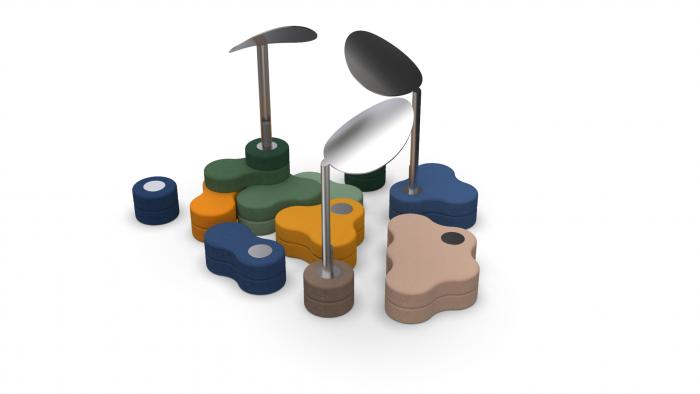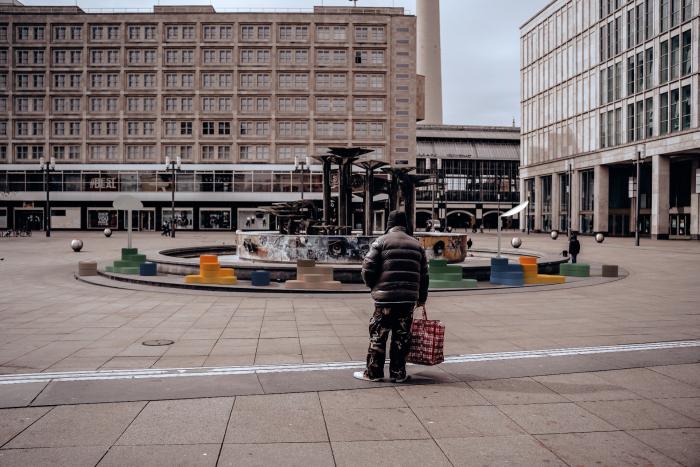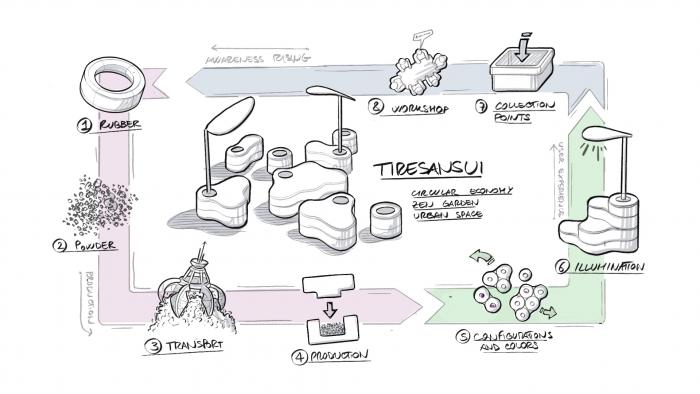The project focuses on carrying out the collection of used tires and using the resulting rubber.
In this case, the work brings together a widespread distribution of collection and post-processing points for this waste, to produce a modular urban area, built around the concept of generating an urban Zen garden.
Tiresansui's modules are created around the shape of the circle, form symbol of Zen philosophy and sustainability.
These modules can overlap and rotate forming multi-level structures.
Tiresansui revolves around the concept of an urban Zen garden, intending to create something sustainable that could redevelop or improve urban spaces.
To achieve this objective, I decided to work on secondary raw materials, focusing on those that originate directly from waste produced in the city to have the maximum possible circularity. I specifically identified the rubber dust deriving from end-of-life tires (ELTs), so I started by analyzing the ELT collection and disposal chain to fully understand the management of this waste and the process that leads to the origin of this second raw material.
The purposes of this analysis are two: first of all, to understand how to use this material in industrial design.
Secondly, raise awareness of the common conscience on issues such as circularity and eco-sustainability, trying to spread the collection and upcycling network of this waste. Thanks to this research, I understood that the powder obtained from the crushing of ELTs retains the main characteristics of the starting rubber as elasticity and resistance to wear and tear. Furthermore, I found out that by adding the ELT powder to certain adhesives generating a compound, it is possible to obtain simple shapes with compression molding.
Then I concentrated on the formal concept. Knowing the possibilities to work the rubber powder, the shape I thought came as a consequence. Tiresansui is composed of four modules that arise from the circle, a symbol of circularity and representative of the Zen philosophy that underlies the construction of a Karesansui, a typical dry Zen garden. This design process led to a modular urban area in ELT rubber powder composed of modules that overlap and rotate around a pivot to find the perfect configuration, just like in the Zen discipline of stone balancing. This practice objective is creating perfectly balanced constructions through the stacking of cylindrical stones.
Thanks to this feature, the project is customizable and multifunctional.
Please highlight how the concept/idea can be exemplary in this context
Sustainability is the core of this project. It is based on the upcycling of end-of-life tires and the material produced by this process.
In Italy, a national authority for ELTs' collection, Ecopneus, manages this supply chain. Ecopneus has regional storage points from which all the waste is taken to the main warehouse in Lombardy where it undergoes the transformation process.
Here the tires undergo a first shattering that reduces them to pieces. Then, these endure the second crushing phase, which is meant to obtain granulates of different diameters. Currently, sports flooring and building insulations use this material. It is also used in smaller quantities to add asphalts or produce street furniture. Therefore, my project wants to expand one of these fields, trying to demonstrate how the ELT granulate is usable also in industrial design. Furthermore, Tiresansui would allow citizens to approach this type of little-known process, which nevertheless appears to be very important. In this way the ELT granules would become part of the common image of the city, raising awareness on the consumption of problematic waste such as tires.
One of the project's aims is to reduce the environmental impact of tire transport and module production as much as possible. To do this, it is planned to structure, together with Ecopneus, a network of provincial collection and storage warehouses. In this way, we would come to have a big drop in consumption related to the needs of Tiresansui, be it the processing of waste or the laying of the urban area. In this sense, it is necessary to reflect on the project's environmental impact. Not only as regards the production of new products, but also on the energy and resource savings that upcycling brings. For example, the use of rubber powder from ELTs has several consequences: first of all, it allows you not to incinerate the tires, preserving the air's health, then it guarantees a high saving of water that would be used to produce virgin material
Please highlight how the concept/idea can be exemplary in this context
The aesthetic aspect of Tiresansui comes from the union of the Zen philosophy and the constraints imposed by the methods of forming the raw material.
The shape around which everything revolves is the circle, a symbol of circularity, union, and perfection. This shape also recalls the smooth and cylindrical stones used in the stone balancing discipline.
The balance of the elements is a fundamental aspect in the Zen methodology, and Tiresansui was born by seeking this harmony.
In this project different types of equilibrium coexist.
There is environmental balance, balancing consumption and savings to conserve a part of those fundamental resources that are quickly running out.
There is formal harmony of the modules and colors, reminiscent of the garden and Japanese culture.
There is a balance with the city, where a product that comes from the city's waste, returns in a new form.
Finally, there is harmony with the citizens who interact with it: the personalization due to the different configurations and arrangements and the different methods of use generates a connection between user and product
The project encompasses all these concepts and makes them explicit through an aesthetic as simple as effective.
Please highlight how the concept/idea can be exemplary in this context
The citizen's active participation turns out to be Tiresansui's inclusive aspect. This project allows users to take advantage of the customization possibilities of the various configurations of the urban area at will, adapting it to different needs. In this way, they create a direct and participatory relationship between subject and object, which is transferred directly to the territory within which Tiresansui falls. Furthermore, ELT rubber powder is a material producible anywhere, making its application sustainable globally.
However, his interesting aspect is the interaction generated between the different citizens who come into contact with this street furniture. Both among those who live there at the same time, and among those who find the area modified by previous inhabitants.
Another Tiresansui inclusive aspect is its modularity, according to one's taste or needs. Its modularity allows you to create areas of different sizes and different purposes, depending on the context in which they are inserted.
Please highlight how this approach can be exemplary
The aspects of inclusiveness, aesthetics, and sustainability are linked by the concept of the garden.
Reference is made to the garden as a place of serenity where people and nature in all its forms coexist.
Tiresansui's will is conceptually transporting this magical space into the city, through a formal reinterpretation.
The material used represents the natural look of the garden. It turns out to be almost a contradiction, but the use of ELT rubber involves a series of environmental consequences that want to preserve nature. Therefore, by preserving it, it represents it.
The overlapping circular elements represent harmony. Just like in the discipline of stone balancing, the elements tend to achieve a harmonious equilibrium.
The habitat of a Zen garden symbolizes inclusiveness. In fact, within it coexist different species of plants, birds, fish, and all four natural elements. In this sense, Tiresansui allows everyone to have a customizable area available to share with other inhabitants of the city's habitat.
The innovative nature of the project lies in the desire to demonstrate that the industrial use of secondary raw materials is possible. By finding a fair trial and relying on its analysis one can find suitable forms.
Furthermore, customizable street furniture is not common in cities. In this sense, we bet on interaction with the citizen and the relationship between man and object to make the city a more livable place.
The systemic part connected to the product is another innovative aspect. The network that Ecopneus uses today to recover exhausted tires is not as efficient as it would be following the model conceived in this project. Transport and installation costs would be reduced both in the harvesting phase and in the post-processing phase, resulting in a considerable environmental advantage.
The possibility of having a public lighting system integrated into the urban area completes the innovative aspects.
The possibility of having an area independent from existing infrastructures is a considerable advantage. Depending on the specific place in which it is located, you can choose whether to have, if necessary, the lighting module or not. This makes Tiresansui complete and more secure by adding a function to the project.
This project could be integrated into an optimized collection system in collaboration with Ecopneus. It is not essential, but it would be able to make the most of it and would also benefit the collection and management chain of the waste in question.
It would be possible to save both in economic and environmental terms. The whole process would be speeded up and consequently also the production of the final product.
On a communication and advertising level, hubs could be implemented to create workshops on the subject of secondary raw materials, with a focus on ELT rubber powder. Doing so would also bring people closer to a still little-known reality, to sensitize them to recycling and attention to waste.
If Tiresansui wins the prize, I would try to understand what further development margin the project could have.
I would advertise it looking for someone interested, perhaps a municipality or a furniture company. I could also try to open a dialogue with Ecopneus having something more concrete in hand than a concept.
@Albazzi, 2022
Content licensed to the European Union.
